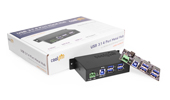An emergency can strike at any time. There is no such thing as a one-size-fits-all crisis situation. From personal incidents like a house fire, to life-threatening medical emergencies, and even protracted natural disasters, emergency situations come in all shapes and sizes. First responders such as emergency medical technicians (EMTs) and the fire department employ a wide variety of life and property saving tools and devices that provide emergency relief. Those devices, however, need a reliable power source. Here are the top five reasons to install a dual port USB charger in your fleet of emergency vehicles.
1. Ensure Communications
Emergency situations are no time to lose contact with your team, your dispatcher, the hospital, or other local agencies like the police. Mounting a dual port USB charger in your fire truck or ambulance gives you a way to charge a variety of wireless communications devices directly off the vehicle’s battery so that your communications tools never run out of the essential power that they need to keep first responders connected.
2. Power Lifesaving Equipment
Hand-held, lifesaving equipment is an essential tool for emergency response personnel, especially EMTs. Thermometers, ultrasound devices, defibrillators, and cutting tools are all necessary emergency equipment that can be charged off of USB-A or USB-C connections. A reliable power source can help first responders meet critical, life-saving emergencies head on, armed with the right tools.
3. Enable GPS Navigation
Responding to an emergency is pointless if first responders can’t find the emergency site. Devices like laptops, tablets, GPS and cell phones all equipped with GPS capabilities can help guide first responders to the location without fear of losing battery charge from power-hungry satellite applications.
4. Provide Updated Information and Alerts
An emergency situation can change rapidly. Crises, especially naturally disasters, evolve dramatically over time. Emergency personnel in the field might not always be aware of incoming danger until it’s too late. By installing a dual port USB charger in your emergency response vehicles, you give first responders the ability to keep important devices well-supplied with power, helping mitigate potential disasters in the process.
5. Triage Remotely with Emergency Healthcare Facilities
Emergency responders use mobile devices, tablets, and laptops to maintain active communication with hospitals and other emergency providers as they transport people. Emergency room personnel need a complete medical picture in order to provide the best critical care possible upon arrival. A mounted USB charging option allows first responders to maintain continuous contact with healthcare providers as they prepare to administer life saving measures.
Reliable, On-site Charging Options
Emergency situations evolve at a rapid pace. First responders need to move quickly in order to prevent loss of life and mitigate property damage. In order to do so, they need to employ cutting-edge, lifesaving tools and devices, and those devices have to be ready at a moment’s notice. There’s no margin of error.
With a dual port USB charger installed in your emergency response vehicles, your first responders never have to worry about running out of precious battery life for their most important tools. The 75 watt charger features both a USB-A and USB-C type charger to ensure that you can charge every one of your devices without any issues. The Chargeit! Unit is built for tough terrain and comes with easy mount flanges, and a durable metal housing. The 75 watt dual charger comes with the 2-pin phoenix connector which provides a variable DC input running from 7 to 24 volts, a 12v automotive option, or a 24 volt industrial option.
Contact Coolgear to learn more about our in-vehicle charging options, including the Chargeit! 75 watt unit, and let us help determine the right solution for your first responder’s needs.



















